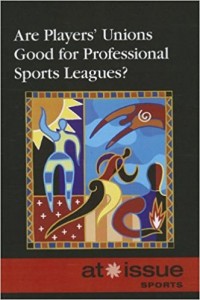Are Players’ Unions Good for Professional Sports?
Are Players’ Unions Good for Professional Sports?
edited by Thomas Riggs (Greenhaven Press, 2013)
Book review by Mark Altschuler. Mark is Professor of English at Bergen Community College (Paramus, NJ) and has taught Baseball and American Culture classes (with Prof. William Burke) at The Institute for Learning in Retirement.
This short book (96 pages) offers 14 short essays that explore the question posed in the book’s title: “Are players’ unions good for professional sports?” Each essay has a clear point of view and makes an argument worthy of consideration. From Roger Goodell, NFL Commissioner, to Arn Tellem, a sports agent and disciple of Marvin Miller, union organizer, to conservative lawyer and commentator Ben Shapiro, to sports columnist Sally Jenkins (and 10 others), all weigh in. The book is a lively read; each essay raises legitimate issues, but the titular question is never definitively answered.
All four major professional sports leagues in the U.S. are addressed: Football, Basketball, Hockey, and Baseball. Major League Baseball, because of its antitrust exemption, has different issues than the other leagues (although the antitrust exemption as applied to MLB’s labor relations was removed by the Curt Flood Act of 1998). The book does an excellent job of explaining the difference between the American professional sports model and the European model, the former being primarily predicated on the market system. One essayist lauds the European system; another blasts that system. The book is nothing if not balanced. I am not an economist so I am not knowledgeable enough to come up with my own point of view.
Thomas Riggs, the book’s editor states in his introduction that the purpose of the book is to show that sports labor disputes “evolve into a debate over the roles that unions play in American society and are rife with implications concerning employer/employee relations.” The essays, taken as a whole, do an excellent job of raising questions, especially concerning the issues of the role of labor unions in post-industrial America, the intersection of race and sports, and the role of fans in the labor struggles in professional sports.
The essays in the book suggest that players’ unions originally served a viable purpose, helping to make salaries and working conditions and competition among teams more equitable. Some essayists in the book believe they continue to do so. Some essayists believe they have outlived their usefulness. Tellem, for example, argues that the NBA and NFL unions consistently make concessions to the owners. He advocates for decertification and individual players filing antitrust lawsuits against the owners as the way forward.
David J. Leonard, a professor of race studies, sees racism inherent in the policies and attitudes of the owners in the NBA and NFL that drive their policies. Leonard suggests the owners have muzzled these players, taken away free speech rights in subtle fashion as part of recent collective bargaining agreements. In light of Colin Kaepernick and players supporting his right to sit or kneel during the playing of the National Anthem, perhaps this is changing. Unlike Michael Jordan (“Republicans buy sneakers, too,”), LeBron James has courageously taken stands for social justice. Of course, Kaepernick is still unemployed.
A theme emerges from the book: in all the negotiations that take place in professional sports, the fans really do not have a voice. Goodell claims in his essay that the owners care about the fans and the players’ union does not. The final essay in the book argues that the publicly-owned Green Bay Packers light the way to the future. Fan ownership, according to Law Professor Roger Groves, might resolve the long sports struggles between owners and labor, although the NFL, at least, now has rules in place to prevent another team from becoming fan-owned. Ah, a world without Jerry Jones, George Steinbrenner or Donald Trump—now that’s an idea really worthy of consideration.

